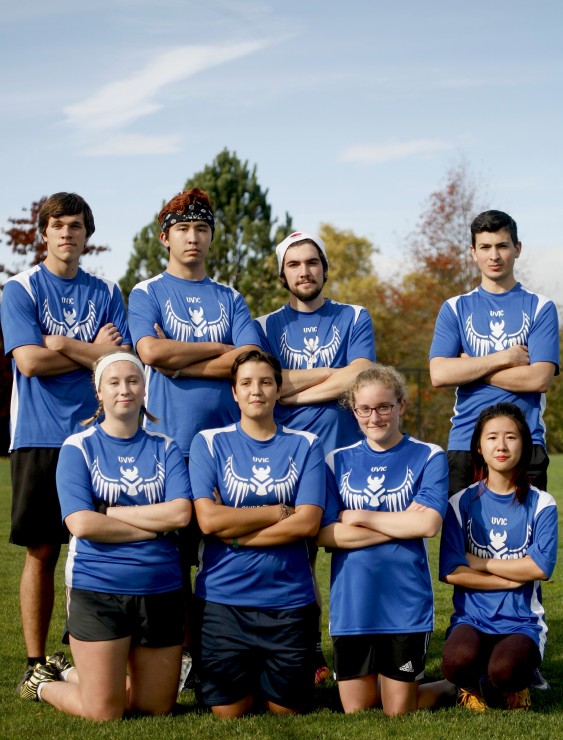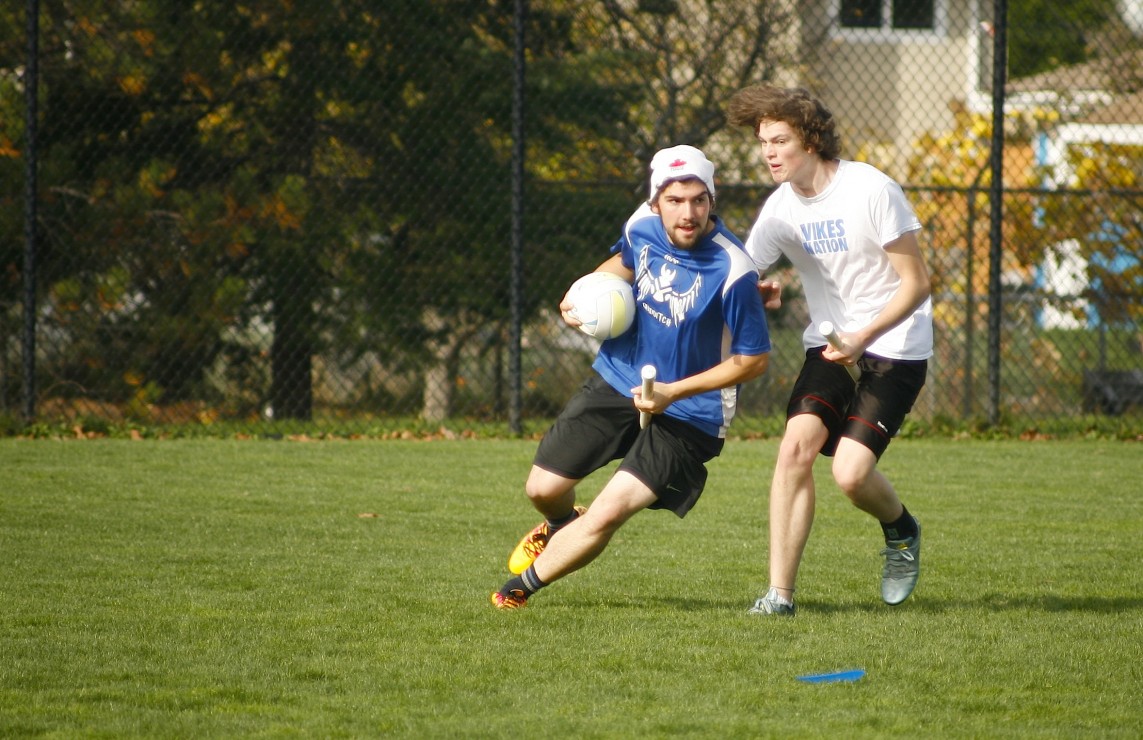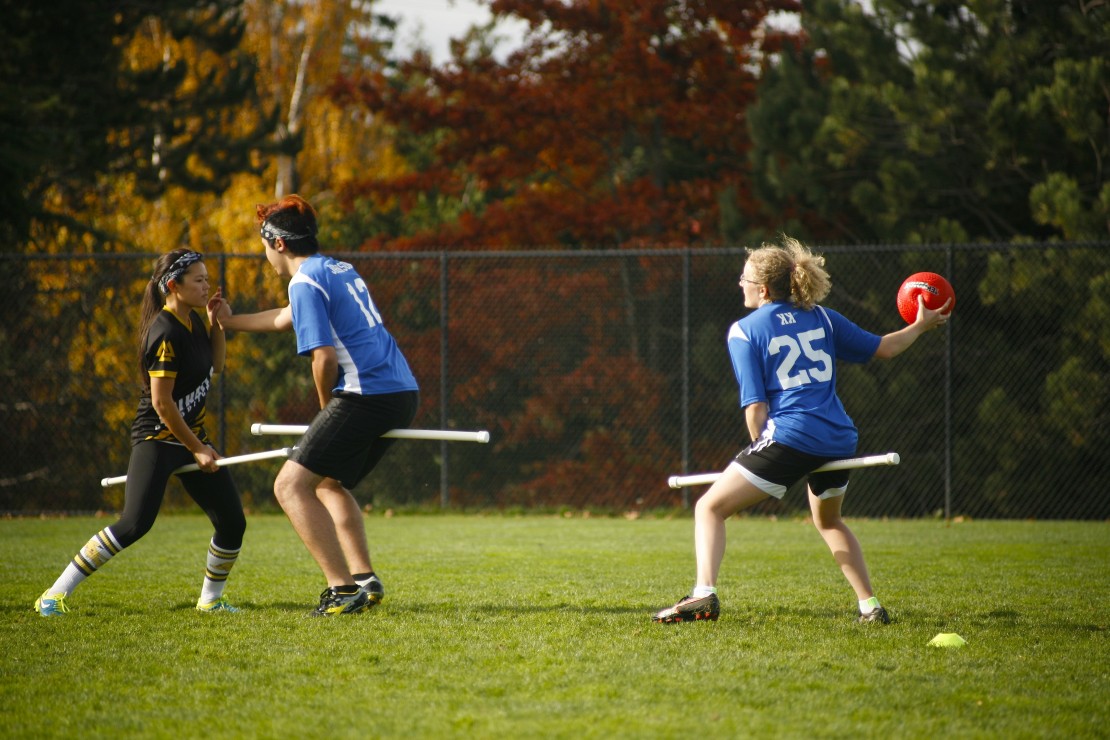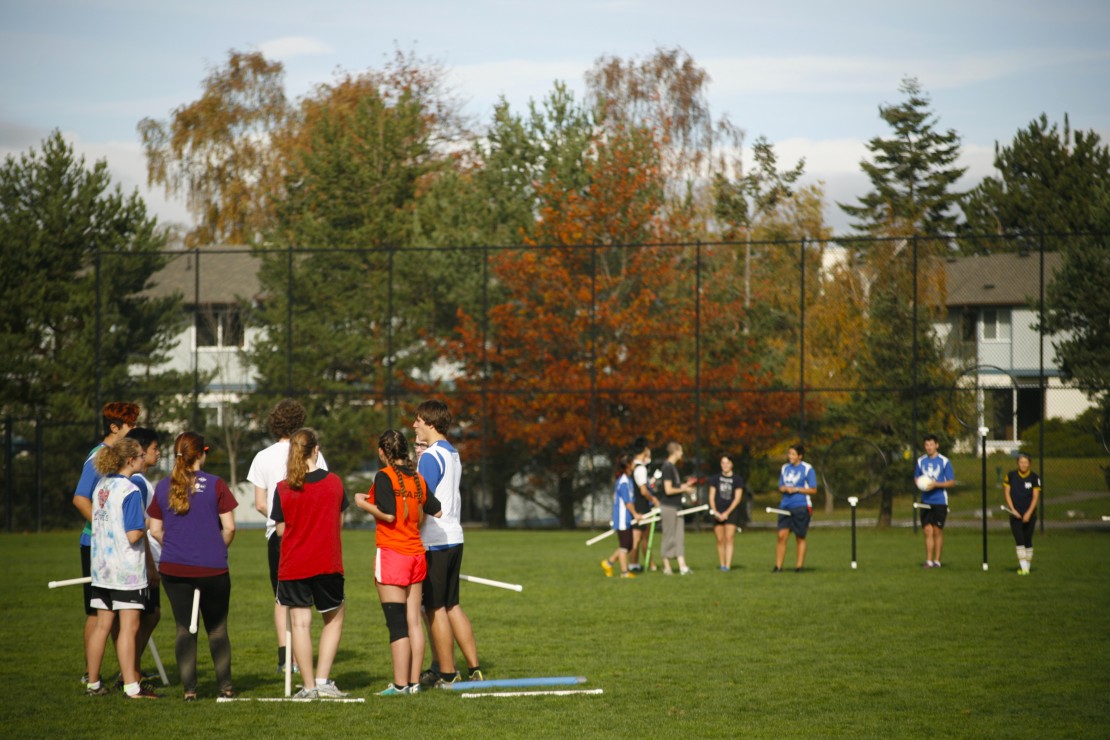Rumours and outright speculation around UVic’s Quidditch team have existed on campus since they started as a club in 2010. Most people know about them, others wonder, and some outright don’t even know they exist. Quidditch is just a Potterhead activity, right?
Actually, it’s a sport that has garnered worldwide interest complete with national teams, world cups, and global games. And as of this semester, the UVic Valkyries have finally been ratified as a Vikes sports club.
Just in time, too, as UVic will host the Quidditch Canadian Nationals in early April next year.
“There’s about 30 teams in Canada,” says Cynthia Chao, Valkyries team president. “Most of them are university affiliated but some are just community teams.”
“I don’t expect every team in Canada to come,” says team captain and acting coach Misha Whittingham, citing the distance between Victoria and the East Coast as an obstacle for some teams. “I would say somewhere more along the lines of twelve to sixteen.”
Regardless of the numbers, that’s a big deal for the Valkyries. “We’re really excited to be hosting,” says Chao, “because it’s a really great chance to just show off the sport for the university and also to just get people to understand what Quidditch is and to see a little bit of it in person.”
Quidditch through the ages
Though its roots are found in the imaginary universe crafted by J. K. Rowling in the Harry Potter series, Quidditch’s real-word iteration began in 2005 with a group of college students at Middlebury College in Vermont. Now, Quidditch is a worldwide full-contact and gender-inclusive sport, complete with a rulebook and international tournaments.
Quidditch was first introduced to Canada in 2008 at McGill University, and a month after the club formed they represented Canada in the second Quidditch World Cup — the first non-American team to compete in a Quidditch tournament. They were soon followed by UVic’s Valkyries. “We are the second-oldest Quidditch team in Canada after McGill,” says Whittingham.
Anna Jessop, Valkyries founder and former captain, originally started the club when she was a residence advisor back in 2010. She planned a Harry Potter residence weekend and learned about the underground world of real-life Quidditch when researching for events. Jessop started the UVic Quidditch Club immediately.
The team originally played on the quad and tried to promote outreach by attracting passersby.
“Our first semester-and-a-half was really rough,” Jessop says. “We had six to eight people coming every week.”
Jessop describes causing a disturbance as the original recruitment strategy: they would run across campus trying to catch the snitch and attempting to engage people by yelling “try to catch the snitch” or “hey, join UVic Quidditch!”
“It was really great,” Jessop says. “We thought it was hilarious — the game — and getting new people in, like ‘oh you didn’t bring your broom? Go grab a stick from the woods’ type of things.”
The following summer, Jessop learned about the 2011 World Cup V (now the U.S. Quidditch Cup) being held in New York. Although teams needed at least twelve players to sign up, and students would have to get funding and make travel arrangements, she went ahead and filled out an application for the club.
“The reason we decided to go to the World Cup in New York was because the closest teams to us were the McGill team or California. We had no one to play against.” In the end, exactly twelve players went and UVic represented one of five Canadian teams.
Over time, more teams sprung up across the West Coast, giving the Valkyries opportunity to practice and play. A year later, some UVic players even traveled all the way to England.
“The [2012] Olympics were going on so they decided to host a Quidditch tournament during the same time in London,” says Jessop. “So it seemed like you were going to London for the Olympics. We had three of our members travel over there and make the first Team Canada.”
Back then, there was less emphasis on skill and more on willingness to participate. “It’s changed since then. Now you really have to qualify, which makes it really hard in Canada because we don’t have the regions like the States do.”

The UVic Valkyries. From left to right, front row: Soleil Heaney, Teigan Miller-Gauthier, Kassidy Smids-Dyk, and Cynthia Chao. Back row: Nicholas Planidin, Lee Johnson, Misha Whittingham, and Patrick McManus.
Photo by Belle White, Photo Editor
Moments of transfiguration
As Quidditch became less of a recreational activity and more of a serious sport, the Valkyries followed suit. Whittingham states, “I kind of mark the beginning of the second generation of the UVic Quidditch Team.”
Originally, there was a broad Quidditch organization called the International Quidditch Association (IQA) run out of the United States that encompassed all players. However, in 2014 it split into separate national leagues, and Quidditch Canada was formed on July 1 along with U.S. Quidditch, Quidditch Mexico, Quidditch U.K., etc., as well as a new IQA no longer affiliated with just the States.
Along with national leagues and teams, each country has their own official standardization of rules. “Everyone follows the U.S. Quidditch rulebook as a basic guideline,” Whittingham says. “The IQA makes a few major amendments every year to that rulebook and then after that, Quidditch Canada has its own minor amendments that are specific to us.”
Along with new leagues comes an entire community around the sport. Whittingham himself works for Quidditch Canada as the Statistics Coordinator and Quidditch Post: one of three news agencies that report on Quidditch games and the development of the sport.
Quidditch Post is the only fully international sports media group with contacts all across the globe — the other two being the Eighth Man — which is U.S. specific with in-depth sports-analytic material — and Face Beat It, a satirical and humour-directed outlet.
Whittingham says that Quidditch Canada’s new-found drive to have Quidditch seen as more respectable inspired the Valkyries to join Vikes Nation and “to be recognized as a sport by our school.”
As a result, they have full access to free fields instead of destroying the turf on the quad. “If you have noticed that brown patch of mud in the middle, that is us. That is entirely our fault. There’s not even a shadow of a doubt. We are the reason that patch of mud is there.”
Even their materials have improved. Originally, the hoops were Christmas tree stands with pop cans filled with rocks used to hold them down; now the Valkyries play with hoops ordered online from a company that specializes in Quidditch equipment.
Not to mention new jerseys arriving this year — just in time for nationals.
The sport and its players
While every sport has their own set of complex rules, Quidditch rules can be quite complicated, with four to five balls in play at any point in time as well as three positions which all have different rights of way.
“The best way I can describe it,” Whittingham says, “is it’s like there is a game of rugby, a game of dodgeball, and a game of capture the flag happening at the same time.” But of course, with a broomstick between your legs at all times.
Each team has three chasers, two beaters, one keeper, and one seeker that is allowed onto the field during the seeker period. While Whittingham admits the game can be confusing to the casual observer, “the best way to understand the sport is to watch it play or to play it yourself. Quidditch is still not at a point where it’s a particularly great spectator sport.”
Chasers
Number of players: Three
Ball: Quaffle
Headband colour: White
“The chasers have a Quaffle,” says Whittingham. “It’s a slightly deflated volleyball. They pass it between each other and put it through the hoops to score goals.” Each time a player puts the Quaffle through an opposing team’s hoop they get ten points. They can do this by throwing, kicking, or in any way passing the ball through the hoop. “It is a full-contact sport, so they’re allowed to tackle one another assuming it’s not from behind or around the neck. There are specific rules around it.”
Keepers
Number of players: One
Ball: Quaffle
Headband colour: Green
“The only difference between the keepers and the chasers,” Whittingham says, “is keepers have zones around the hoops. If they’re in it and they get the quaffle, they can’t be touched, they can’t be beat, they can’t be tackled, so they’re just safe.”
The keeper’s role is to prevent opponents from scoring on their team’s hoops. A goal can be scored from either side of the hoop, but keepers are the only player that can put their hands through a hoop in order to stop a goal. If anyone other than the keeper does so, then the goal automatically counts.
Beaters
Number of players: Two
Ball used: Bludger
Headband colour: Black
The sole purpose of beaters is to throw, kick, or otherwise propel a bludger at other players to disrupt the flow of the game. “If you get hit, you’ve been ‘knocked off your broom’ just like dodgeball,” says Whittingham. However, if you catch a bludger then you haven’t been hit.
Defensive and offensive strategyies revolve around how beaters are used. “Beaters become really useful defensively because they can effectively, all on their own, stop attacks,” Whittingham says.
Since there are four beaters and only three bludgers on the field at a time, one team is always going to have a disadvantage. One team cannot have more than two balls at the same time, and they cannot guard the third bludger if they have two already.
“So in Canada we refer to that as Bludger Superiority when you have two bludgers, or B.S,” says Whittingham.
Seeker
Number of players: One
Ball used: Snitch
Headband colour: Yellow
“Seventeen minutes into the game the snitch is released onto the pitch,” says Whittingham. The snitch acts as an official — just like any of the referees — and is dressed all in yellow. Similar to touch football, the ‘snitch’ has a sock with a tennis ball in it velcroed to the back of their shorts.
“A minute after the snitch is released, the seekers — one from each team — are released onto the pitch,” Whittingham says. “Their job is to catch the snitch. Catching the snitch is worth thirty points whereas every goal is worth ten.” When a team catches the snitch, “it ends the game just like in the old books.”
However, strategy is key when using the snitch. If a team is down by more than thirty points, a seeker will often choose to defend the snitch until their team is within the thirty-points range.
“You’ll sit there in front of the snitch and fend off the other seeker with the snitch’s help,” says Whittingham, “because the snitch just doesn’t want to get caught, period.”
A snitch is also the only person on the field who can take a broom out from beneath a player. “A lot of the snitches are highly trained judo or jiu-jitsu artists,” Whittingham explains. “A lot of them are cross-country runners, or just dicks. Just really good at being nasty.”
The gender rule
Besides the fact that Quidditch is full contact, the sport is officially co-ed. “The basic concept of the gender rule,” says Whittingham, “is essentially on any given point in time on the field you may have no more than four players of the same identified gender.”
The rule classifies players on their gender identity — which does not mean their sex. “There’s only seven players at most which means you can have a majority of one gender, but that gender is never more than four players,” Whittingham says. However, the rule has proved contentious.
“Some people in the last year have been calling for the rule to change from a gender rule to a sex rule primarily because [biological] males just have an inherent advantage athletically,” Whittingham explains. “In the U.K., and at some points the U.S., that has been abused where people will claim to be of genders that they don’t identify as because it gives their team an athletic advantage.”
This rule, and other aspects of the game, can stir up considerable debate between people in the Quidditch community. “A lot of people — myself included — kind of feel in part responsible for how the sport does,” says Whittingham, “because a lot of us have been a major part of helping this sport grow and watching it kind of mature.
“But as a result, people get really attached to the way they think the game should be played and how they think it should be perceived. So, that can lead to friction.”
The evolution of the game
Quidditch is developing at such a fast rate and in diverse and isolated locations, that there are always new aspects to the game. For example, Whittingham explains that Quidditch on the east coast of Canada is vastly different to the west, which only gets more complicated when you add American teams, and then the international leagues.
“It is hard to coach this sport,” Whittingham admits. “I swear to God it’s like three months and there’s a new strategy — there’s a new best way to do things.”
“Every region has its own kind of way that they end up playing against each other,” he says. This has made the sport evolve independently to each area.
“It’s actually very competitive and quite athletic,” says Kassidy Smids-Dyk, Valkyries beater captain, who is in charge of all the beater drills and strategy. “There’s a huge variety of skill levels.”
Muggles and mudbloods welcome
“I’ve never been a part of a sport with such an active and involved community that cares so much about how it progresses and how we’re going,” says Whittingham. “I swear the international Quidditch community is like its own country. Isolated from the rest of the world. We live in our own little bubble.”
Cynthia Chao says, “I got into it for the Harry Potter but it’s also just a great community of people and it’s a great sport. Everyone that I’ve met has been just basically a great person.”
Smids-Dyk says, “It’s kind of like you’re doing exercise but you don’t even notice it because you’re having fun.”
“I really enjoy it,” says a current rookie member who goes by the name Purple. “I love the sense of community. I generally despise team sports with every fibre of my being but this has been very different.”
If you’re interested in catching a match, the Valkyries will be playing on Sunday, Nov. 6, at 12–4 p.m. at UVic Field #7. Anyone interested in joining the team or getting involved can contact the UVic Valkyries through Facebook or their website at uvicquidditch.weebly.com.











